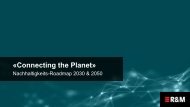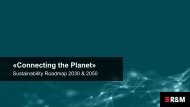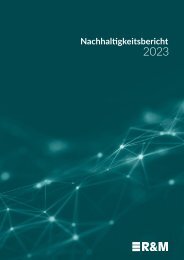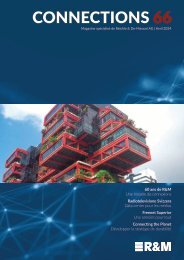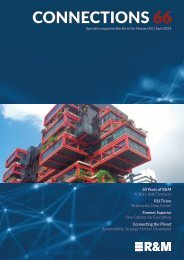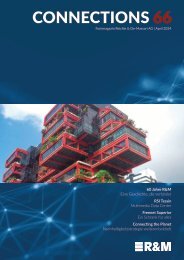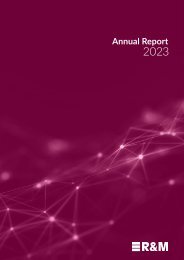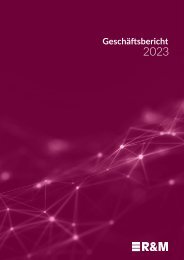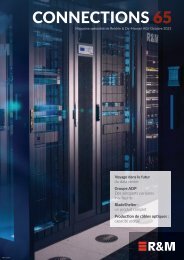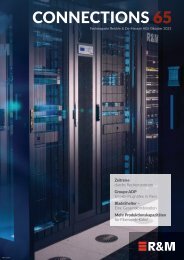CONNECTIONS_55-e
R&M customer magazine, Connectivity, Cabling, Fiber Optica, Copper
R&M customer magazine, Connectivity, Cabling, Fiber Optica, Copper
Create successful ePaper yourself
Turn your PDF publications into a flip-book with our unique Google optimized e-Paper software.
Trends<br />
IT Asset Management<br />
– It’s Worth It<br />
It is impossible to manage a modern data center without a one-hundred-percent<br />
real-time overview of the hardware. This is why automated IT asset tracking is essential.<br />
There are a number of reasons why.<br />
050.6711<br />
IT asset tracking is a system for digitally<br />
managing all IT assets of a company or data<br />
center. This approach extends well beyond<br />
just a snapshot of the current situation. It also<br />
covers the management of the life cycle of<br />
computers, memories, servers, networks and<br />
everything associated with them.<br />
An asset will typically pass through more than<br />
a dozen areas of responsibility from being<br />
purchased to being decommissioned. Along<br />
Asset Management Process Overview<br />
Identify the need<br />
Several departments agree<br />
on purchasing IT equipment<br />
Deploy<br />
Asset is racked and<br />
in operation<br />
Purchase<br />
Equipment is shipped<br />
to data center<br />
Planning<br />
Several departments agree<br />
on where to put it<br />
this path there can be misunderstandings,<br />
inefficiency and mistakes. Only carefully<br />
carried out asset management can reduce or<br />
even exclude such problems.<br />
Further reasons and benefits:<br />
– Finances: Financial accounting requires an<br />
overview of the company’s assets. IT asset<br />
tracking helps to create overviews which<br />
are as precise and as up to date as possible.<br />
– Quality: Quality and asset management<br />
Arrival at warehouse<br />
Equipment is registered<br />
as an asset<br />
Tracking begins<br />
Asset is entered in CMDB<br />
(e.g. ISO <strong>55</strong>000) require regular audits. An<br />
IT department will cut a convincing figure in<br />
every audit if it practices good asset tracking.<br />
– Geography: Those responsible often work<br />
decentrally or not where IT is situated.<br />
They can still have an overview with asset<br />
tracking.<br />
– Outsourcing: More and more external<br />
specialists are coming into data centers<br />
because services have been outsourced.<br />
Asset tracking supports monitoring in such<br />
cases.<br />
– Knowledge: The planning, operation and<br />
control of IT are often based on the implicit<br />
knowledge of just a few people. What<br />
happens if these privileged few are not<br />
available? Asset tracking makes detailed<br />
knowledge available to all those responsible<br />
at all times.<br />
– Documentation: People responsible for IT<br />
are still working with manual methods to<br />
acquire operating data, share information<br />
and manage capacities. IT asset tracking<br />
with systems available today automates<br />
this process.<br />
– Decommissioning: Obsolete hardware is<br />
simply ignored or forgotten about so as not<br />
to have to disturb the operating procedure<br />
or endanger service level agreements. This<br />
decommissioning process would be taken<br />
care of in a flash with continuous asset<br />
tracking.<br />
050.6713<br />
Audit<br />
Twice a year all asset<br />
need to be audited<br />
Redeploy<br />
Asset needs to move in<br />
case racks have to be<br />
End of life<br />
Audit detailing decommissioning<br />
is required<br />
050.5774<br />
Dr. Jan Kupec<br />
Innovation Project Manager<br />
jan.kupec@rdm.com<br />
32 10I2018–<strong>55</strong> <strong>CONNECTIONS</strong>






